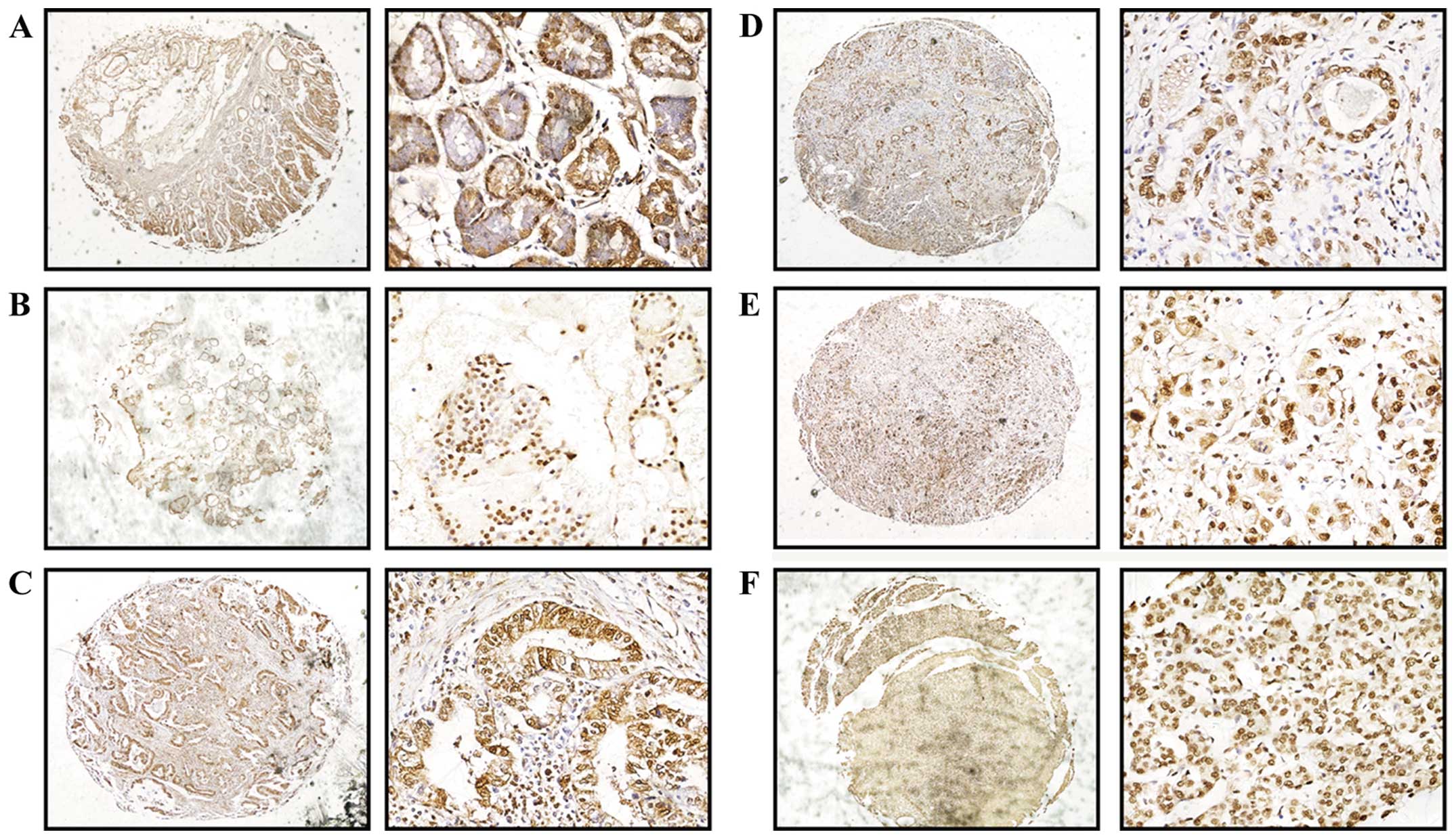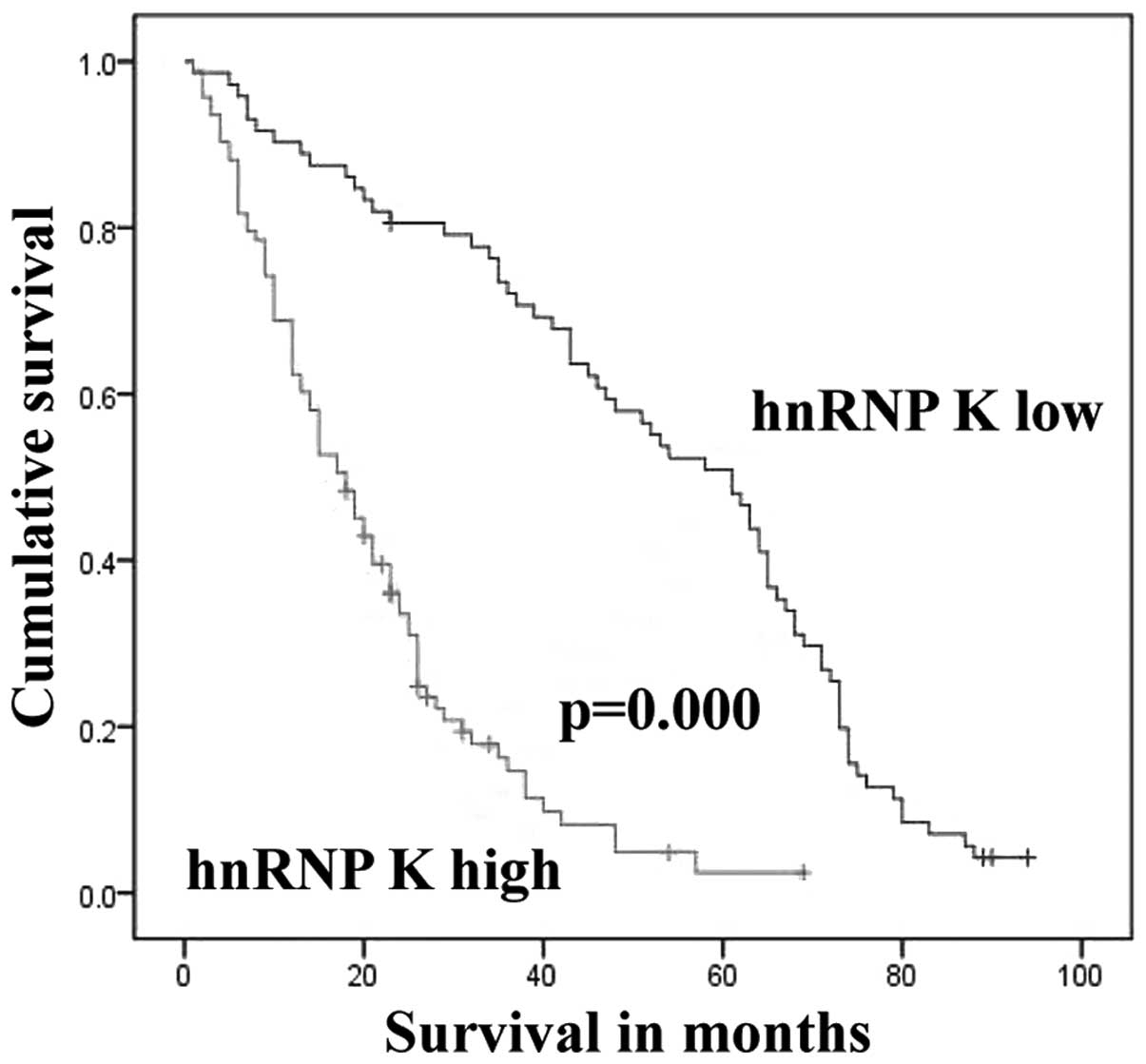|
1
|
Luyimbazi D, Nelson RA, Choi AH, Li L,
Chao J, Sun V, Hamner JB and Kim J: Estimates of conditional
survival in gastric cancer reveal a reduction of racial disparities
with long-term follow-up. J Gastrointest Surg. 19:251–257. 2015.
View Article : Google Scholar
|
|
2
|
Ferlay J, Steliarova-Foucher E,
Lortet-Tieulent J, Rosso S, Coebergh JW, Comber H, Forman D and
Bray F: Cancer incidence and mortality patterns in Europe:
Estimates for 40 countries in 2012. Eur J Cancer. 49:1374–1403.
2013. View Article : Google Scholar : PubMed/NCBI
|
|
3
|
Ferro A, Peleteiro B, Malvezzi M, Bosetti
C, Bertuccio P, Levi F, Negri E, La Vecchia C and Lunet N:
Worldwide trends in gastric cancer mortality (1980–2011), with
predictions to 2015, and incidence by subtype. Eur J Cancer.
50:1330–1344. 2014. View Article : Google Scholar : PubMed/NCBI
|
|
4
|
Deng X, Jin X, Xue S, Zhang X, Su H, Zhang
P and Xie C: Postoperative chemoradiotherapy for advanced gastric
cancer after D2 gastrectomy. Hepatogastroenterology. 61:1472–1477.
2014.PubMed/NCBI
|
|
5
|
Zheng CH, Lu J, Huang CM, Li P, Xie JW,
Wang JB and Lin JX: Treatment of locally advanced gastric cancer
with the XELOX program of neoadjuvantchemotherapy combined with
laparoscopic surgery: The experience in China.
Hepatogastroenterology. 61:1876–1882. 2014.
|
|
6
|
Jiang X, Du L, Wang L, Li J, Liu Y, Zheng
G, Qu A, Zhang X, Pan H, Yang Y, et al: Serum microRNA expression
signatures identified from genome-wide microRNA profiling serve as
novel noninvasive biomarkers for diagnosis and recurrence of
bladder cancer. Int J Cancer. 136:854–862. 2015. View Article : Google Scholar
|
|
7
|
Zeng X, Liao AJ, Tang HL, Yi L, Xie N and
Su Q: Screening human gastric carcinoma-associated antigens by
serologic proteome analysis. Ai Zheng. 26:1080–1084. 2007.In
Chinese. PubMed/NCBI
|
|
8
|
Wang F, Zhang P, Shi C, Yang Y and Qin H:
Immunohistochemical detection of HSP27 and hnRNP K as prognostic
and predictive biomarkers for colorectal cancer. Med Oncol.
29:1780–1788. 2012. View Article : Google Scholar
|
|
9
|
Chen Y, Li W and Zhang S: hnRNP K
expression and its clinical significance in human lung cancer
tissues. Zhongguo Fei Ai Za Zhi. 11:241–245. 2008.In Chinese.
PubMed/NCBI
|
|
10
|
Guo Y, Zhao J, Bi J, Wu Q, Wang X and Lai
Q: Heterogeneous nuclear ribonucleoprotein K (hnRNP K) is a tissue
biomarker for detection of early hepatocellular carcinoma in
patients with cirrhosis. J Hematol Oncol. 5:372012. View Article : Google Scholar : PubMed/NCBI
|
|
11
|
Namikawa T, Kobayashi M and Hanazaki K:
Esophageal tumor after radical surgery for gastric cancer.
Gastroenterology. 148:e9–e10. 2015. View Article : Google Scholar : PubMed/NCBI
|
|
12
|
Don KR, Ramani P, Ramshankar V, Sherlin
HJ, Premkumar P and Natesan A: Promoter hypermethylation patterns
of P16, DAPK and MGMT in oral squamous cell carcinoma: A systematic
review and meta-analysis. Indian J Dent Res. 25:797–805. 2014.
View Article : Google Scholar
|
|
13
|
Gross H, Hennard C, Masouris I, Cassel C,
Barth S, Stober-Grässer U, Mamiani A, Moritz B, Ostareck D,
Ostareck-Lederer A, et al: Binding of the heterogeneous
ribonucleoprotein K (hnRNP K) to the Epstein-Barr virus nuclear
antigen 2 (EBNA2) enhances viral LMP2A expression. PLoS One.
7:e421062012. View Article : Google Scholar : PubMed/NCBI
|
|
14
|
Barboro P, Salvi S, Rubagotti A, Boccardo
S, Spina B, Truini M, Carmignani G, Introini C, Ferrari N, Boccardo
F, et al: Prostate cancer: Prognostic significance of the
association of heterogeneous nuclear ribonucleoprotein K and
androgen receptor expression. Int J Oncol. 44:1589–1598.
2014.PubMed/NCBI
|
|
15
|
Zhao Y, Jin X, Tian T and Yu DH:
Expression of hnRNPK in gastric carcinoma and its relationship with
Helicobacter pylori L-form infection. Zhonghua Zhong Liu Za Zhi.
33:759–763. 2011.In Chinese.
|
|
16
|
Xia YJ, Ma YY, He XJ, Wang HJ, Ye ZY and
Tao HQ: Suppression of selenium-binding protein 1 in gastric cancer
is associated with poor survival. Hum Pathol. 42:1620–1628. 2011.
View Article : Google Scholar : PubMed/NCBI
|
|
17
|
Xiang M, Zeng Y, Yang R, Xu H, Chen Z,
Zhong J, Xie H, Xu Y and Zeng X: u6 is not a suitable endogenous
control for the quantification of circulating microRNAs. Biochem
Biophys Res Commun. 454:210–214. 2014. View Article : Google Scholar : PubMed/NCBI
|
|
18
|
Thompson PJ, Dulberg V, Moon KM, Foster
LJ, Chen C, Karimi MM and Lorincz MC: hnRNP K coordinates
transcriptional silencing by SETDB1 in embryonic stem cells. PLoS
genet. 11:e10049332015. View Article : Google Scholar : PubMed/NCBI
|
|
19
|
Wojtuszkiewicz A, Assaraf YG, Maas MJ,
Kaspers GJ, Jansen G and Cloos J: Pre-mRNA splicing in cancer: The
relevance in oncogenesis, treatment and drug resistance. Expert
Opin Drug Metab Toxicol. 11:673–689. 2015. View Article : Google Scholar
|
|
20
|
Boisvert M, Bouchard-Lévesque V, Fernandes
S and Tijssen P: Classic nuclear localization signals and a novel
nuclear localization motif are required for nuclear transport of
porcine parvovirus capsid proteins. J Virol. 88:11748–11759. 2014.
View Article : Google Scholar : PubMed/NCBI
|
|
21
|
Cao W, Razanau A, Feng D, Lobo VG and Xie
J: Control of alternative splicing by Forskolin through hnRNP K
during neuronal differentiation. Nucleic Acids Res. 40:8059–8071.
2012. View Article : Google Scholar : PubMed/NCBI
|
|
22
|
Adolph D, Flach N, Mueller K, Ostareck DH
and Ostareck-Lederer A: Deciphering the cross talk between hnRNP K
and c-Src: The c-Src activation domain in hnRNP K is distinct from
a second interaction site. Mol Cell Biol. 27:1758–1770. 2007.
View Article : Google Scholar :
|
|
23
|
Moritz B, Lilie H, Naarmann-de Vries IS,
Urlaub H, Wahle E, Ostareck-Lederer A and Ostareck DH: Biophysical
and biochemical analysis of hnRNP K: Arginine methylation,
reversible aggregation and combinatorial binding to nucleic acids.
Biol Chem. 395:837–853. 2014. View Article : Google Scholar : PubMed/NCBI
|
|
24
|
Osborne MJ and Borden KL: The eukaryotic
translation initiation factor eIF4E in the nucleus: Taking the road
less traveled. Immunol Rev. 263:210–223. 2015. View Article : Google Scholar
|
|
25
|
Wen F, Shen A, Shanas R, Bhattacharyya A,
Lian F, Hostetter G and Shi J: Higher expression of the
heterogeneous nuclear ribonucleoprotein k in melanoma. Ann Surg
Oncol. 17:2619–2627. 2010. View Article : Google Scholar : PubMed/NCBI
|
|
26
|
Belli AK, Elibol F and Ozcan O: Other
factors related to the completion of treatment after breast cancer.
Breast. 24:2832015. View Article : Google Scholar : PubMed/NCBI
|
|
27
|
Xiao Z, Ko HL, Goh EH, Wang B and Ren EC:
hnRNP K suppresses apoptosis independent of p53 status by
maintaining high levels of endogenous caspase inhibitors.
Carcinogenesis. 34:1458–1467. 2013. View Article : Google Scholar : PubMed/NCBI
|
|
28
|
Ling H, Fabbri M and Calin GA: MicroRNAs
and other non-coding RNAs as targets for anticancer drug
development. Nat Rev Drug Discov. 12:847–865. 2013. View Article : Google Scholar : PubMed/NCBI
|
|
29
|
Carpenter B, McKay M, Dundas SR, Lawrie
LC, Telfer C and Murray GI: Heterogeneous nuclear ribonucleoprotein
K is over expressed, aberrantly localised and is associated with
poor prognosis in colorectal cancer. Br J Cancer. 95:921–927. 2006.
View Article : Google Scholar : PubMed/NCBI
|
|
30
|
Wu CS, Chang KP, Chen LC, Chen CC, Liang
Y, Hseuh C and Chang YS: Heterogeneous ribonucleoprotein K and
thymidine phosphorylase are independent prognostic and therapeutic
markers for oral squamous cell carcinoma. Oral Oncol. 48:516–522.
2012. View Article : Google Scholar : PubMed/NCBI
|
|
31
|
Inoue A, Sawata SY, Taira K and Wadhwa R:
Loss-of-function screening by randomized intracellular antibodies:
identification of hnRNP-K as a potential target for metastasis.
Proc Natl Acad Sci USA. 104:8983–8988. 2007. View Article : Google Scholar : PubMed/NCBI
|














